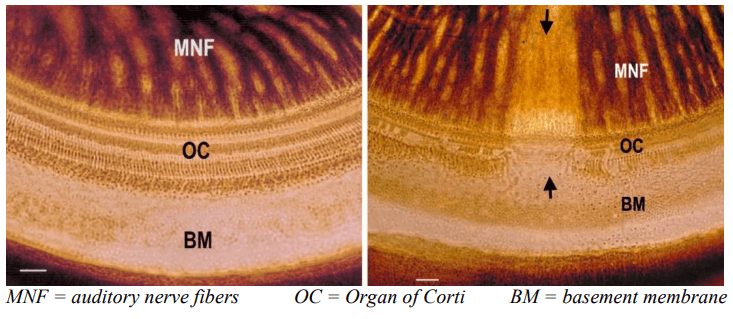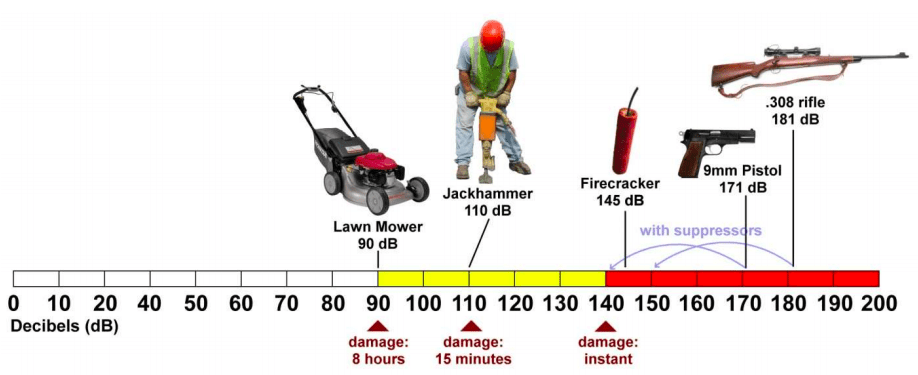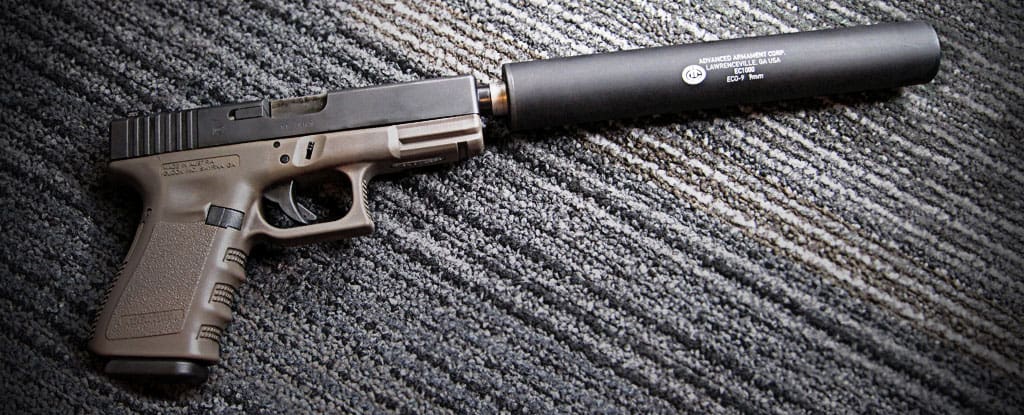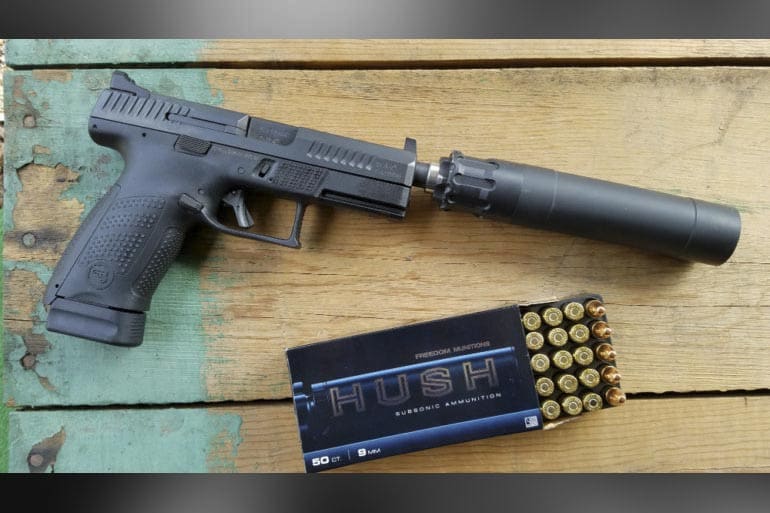
Just as with bump stocks, now that a suppressor has been used in one high profile crime, a move is afoot to ban the already highly regulated safety devices. Because any opportunity to roll back firearms freedoms for Americans will always be seized upon by the Civilian Disarmament Industrial Complex.
That’s why we thought it would be timely to run the official position paper on suppressor use that was issued by Doctors for Responsible Gun Ownership back in 2017, when the Hearing Protection Act still seemed like it might be a reality.
Introduction
The causal relationship between loud noise exposure and irreversible hearing loss has long been recognized by medicine and the U.S. government. Chronic tinnitus (ringing in the ears) may accompany such permanent hearing loss.
Decades ago, the Occupational Safety and Health Administration (OSHA) defined noise levels that are risks to human hearing and standards to ameliorate them.3 These standards are soundly based on research on the effects of escalating sound levels on inner ear hair cell damage resulting in permanent hearing loss and tinnitus.
Cochlear Hair Cells and Noise Induced Hearing Loss
The National Institute on Deafness and Other Communicative Disorders (NIDCD) discusses cochlear hair cell damage in the inner ear that results in Noise Induced Hearing Loss (NIHL): [4]

A protein called gamma-actin helps repair mild to moderate ciliary damage, but cannot restore permanent damage from high-decibel noise such as from jet engines, loudly amplified music and, worse yet, explosive blast damage from gunfire. [5]
In this photomicrograph from a 1999 article Effects of Noise on Hearing in the Journal of the American Medical Association, intact and healthy sensory cells of the inner ear are shown on the left, and damaged cells from excessive noise exposure on the right: [6]

Explosive blast hearing damage
Particularly harmful for firearms enthusiasts is the explosive blast (or impulse) generated when firing a handgun or rifle. This explosive blast generates 1,000 times more pressure than the actual noise of a gunshot. Such blasts can result in significant, permanent hearing loss with a single exposure of 140 decibels or more, according to OSHA in the above referenced report. [3] This is the same “acoustic blast trauma” suffered by survivors of IEDs on the battlefield. Muzzle blast sound levels for most firearms (handguns, rifles and shotguns) range from 140 to over 170 decibels, more than sufficient to cause instant, permanent hearing damage.
An article from Military Medical Research in 2015 that discusses the etiology, pathology and impact of hearing loss from such powerful blast noise (particularly from munitions and aircraft) concludes: “Prevention is still the mainstay of treatment and soldiers need to be educated with regards to the use of hearing protection devices.” [7] According to the U.S. Department of Veterans Affairs: “Hearing loss, including tinnitus, which is a ringing, buzzing or other type of noise that originates in the head, is the most prevalent service-connected disability among Veterans, with many Veterans suffering from a form of it due to frequent exposure to loud noises from weaponry and aircraft.” [8] According to the Centers for Disease Control in Summary Health Statistics for U.S. Adults: National Health Interview Survey, 2012, “15% of adults aged 18 and over had some hearing trouble without a hearing aid,” which amounts to nearly 38 million Americans.[9] [Emphases added.]
Auditory injuries sustained by bystanders are the same as for shooters. In fact, bystanders may not be prepared with any ear protection, and not anticipate the gunshot. Dr. Gianoli has “encountered several patients who had hearing loss from someone else shooting when they weren’t ready.”
Any intervention that reduces these morbidities, and certainly one that firearms users will gladly pay for themselves if it becomes affordable and readily available, could save billions of dollars in costly interventions. There is no treatment for this kind of hearing loss.
Hearing protection Hearing protection in the form of ear plugs or ear muffs, alone or in combination, can only reduce noise exposure by approximately 20-30 decibels. This limitation in noise reduction may still expose a firearms user to damaging levels of noise; 120 decibels is still louder than a car horn from three feet away. Thus, inside the canal and over the ear devices (i.e., ear plugs and ear muffs)—the only current generally available protection—are inadequate for impulse noise protection, and when used together they deafen the wearer to all external sound.
Research that demonstrates the superiority of suppressors over earplugs or earmuffs has been published by Matthew P. Branch, MD. In Comparison of Muzzle Suppression and Ear-Level Hearing Protection in Firearm Use (Otolaryngology-Head and Neck Surgery, 144(6) 950-953), he found that “All suppressors offered significantly greater noise reduction than ear-level protection, usually greater than 50% better. Noise reduction of all ear-level protectors is unable to reduce the impulse pressure below 140 dB for certain common firearms, an international standard for prevention of sensorineural hearing loss . . . Modern muzzle-level suppression is vastly superior to ear-level protection and the only available form of suppression capable of making certain sporting arms safe for hearing.” [10] [Emphasis added.]
Firearms suppressors, which have been popularly called “silencers”, do not make a weapon silent. That is Hollywood fiction. Commercially available firearms suppressors can alone reduce muzzle blast noise by around 30 decibels. Using a suppressor on a firearm concurrently with proper ear protection can reduce the amount of noise from shooting to safe levels safe for enthusiasts. Graphic from the Gun Owners Civil Rights Alliance in Minnesota: [11]

The Centers for Disease Control, in a September 2011 report titled Noise and Lead Exposures at an Outdoor Firing Range—California, documents the importance of hearing protection in shooting. It determined that noise levels above 160 decibels are routine at gun ranges and how even repeated exposure at lower decibel levels can be as damaging as fewer exposures at higher levels. It recommended “double protection” (i.e., earplugs and earmuffs used together) as the best currently available protection. But it noted that “The only potentially effective noise control method to reduce students’ or instructors’ noise exposure from gunfire is through the use of noise suppressors that can be attached to the end of the gun barrel. However, some states do not permit civilians to use suppressors on firearms.” [12] [Emphases added.]
There is no effective treatment for hearing loss from high decibel acoustic blast noise. Maximal prevention is the only possible intervention. For shooters and bystanders, that begins with suppressors mounted on the firearms and may extend to supplemental use of earplugs and/or earmuffs.
But thanks to the 1934 National Firearms Act, gun suppressors are treated like machine guns. In states where they are allowed, they are still federally taxed and permitted, making their effective cost hundreds of dollars and requiring the applicant to wait at least 6 months before actually obtaining one. [13]
The contrast in strict U.S. regulation of suppressors to countries with stricter overall gun control like New Zealand and most of Europe where suppressors are entirely unregulated, effective and inexpensive is remarkable.
Other concerns
Concerns have been raised that minimizing restrictions to acquiring suppressors will result in increasing their use during commission of crimes and in greater difficulty identifying shots fired. But gunshots cannot be “silenced” below about 120 decibels. That is still very loud. Even the anti-gun Violence Policy Center in a February 2016 report claiming to document the dangers of suppressed gunfire, acknowledges its other advantages: greater barrel stability and less muzzle flip and recoil resulting in greater accuracy; enabling verbal communication among shooters (who needn’t be deafened by the noise or by their total ear protection); and eliminating muzzle flash, preserving night vision. [14]
Fearing the spread of criminal use of suppressors to conceal shootings is phobic, not reality-based. There are over 900,000 registered suppressors in America as of 2016. [15] In a 2007 paper, Paul Clark estimates that there are no more than 200 state and federal prosecutions each year for illegal silencer use. [16] That’s just a 0.02% rate.
Criminals prefer readily concealed firearms and are less concerned with the noise they produce. Homemade silencers can be made or other items repurposed very cheaply for single use, making the cost of buying a commercial suppressor even less attractive to criminals. And adding a commercial suppressor to a handgun typically doubles its length, making concealment much more difficult.
See illustration below:

Conclusion
In a January 2017 presentation just published online by The Laryngoscope, the authors concluded: “Substantial noise exposures with potentially serious long-term hearing health consequences frequently are occurring . . . with the use of firearms. Only a minority of those exposed consistently are using hearing protection. Healthcare providers should actively . . . encourage the use of hearing protection with those patients at risk.” [17]
Doctors for Responsible Gun Ownership strongly supports making firearm suppressors readily available to the public as a critical health intervention to prevent Americans’ hearing loss. Reducing barriers to firearms suppressor ownership and decreasing the likelihood of gunshot blast noise induced hearing loss and tinnitus in tens of millions of U.S. firearms owners will have no material impact on criminal firearms use.
References:
1 H.R.367 – Hearing Protection Act of 2017
2 S.59 – Hearing Protection Act of 2017
3 OSHA Regulations (Standards – 29 CFR) – 1910.95(a)
4 NIDCD: Noise-Induced Hearing Loss
5 Gamma-actin is required for cytoskeletal maintenance but not development. BelyantevaI, Perrin B et al, Proc Natl Acad Sci USA, 2009 Jun 16;106(24):9703-8. 6 Effects of noise on hearing. ClarkeW & BohneB, JAMA, 1999;281(17):1658-1659. 7 Effect of Noise on hearing in the military. JongJ & WangD, Mil Med Res. 2015; 2:6.
8 National Audiology Awareness Month: Helping Veterans with hearing loss. VAntage Point: Official Blog of the U.S. Department of Veterans Affairs. October 5, 2016.
9 CDC: Summary Health Statistics for U.S. Adults: National Health Interview Survey, 2012. Vital and Health Statistics, Series 10, Number 260, February 2014.
10 Comparison of Muzzle Suppression and Ear-Level Hearing Protection in Firearm Use. BranchM, Otolaryngology-Head and Neck Surgery, 144(6) 950-953.
11 GOCRA Briefing: Sound Suppressors – Mufflers for Firearms. Gun Owners Civil Rights Alliance (Minnesota), March 2, 2015.
12 Noise and Lead Exposures at an Outdoor Firing Range─California. CDC Health Hazard Evaluation Report, ChenL & BrueckS, HETA 2011-0069-3140, September 2011.
13 Map: Suppressor Legality & Ownership. American Suppressor Association.
14 Silencers: A Threat to Public Safety. Violence Policy Center, February 2016.
15 Firearms Commerce in the United States: Annual Statistical Update 2016. United States Department of Justice—Bureau of Alcohol, Tobacco, Firearms and Explosives.
16 Criminal Use of Firearms Silencers. ClarkP, Western Criminology Review 8(2), 44–57 (2007).
17 Epidemiology of firearm and other noise exposures in the United States. BhattJ, LinH, BhattacharyyaN, The Laryngoscope online preview, March 16, 2017.



Long overdue that we’re allowed sound suppressors as a public/medical device.Same applies to flash reducers/suppressors-find that out if you have glaucoma/cataracts like me.To hell with the hoplophobes.
You may have just hit on something –
A medical device. A needed medical device.
How can we exploit that to our advantage?
Can you then buy them with a Health Savings Account? Will top level insurance plans cover them if you already have loss and/or tinnitus? 😎
The left has a solution for gun noise already and it’s not what we prefer. Suppressors will not survive a Democrat controlled government and are at risk right now.
The logistics on outlawing silencers are substantially more complicated than outlawing bump stocks.
Part of me wants them to outlaw silencers because I’m pretty sure doing so will be the effective death of the NFA. It would be a government overreach that can’t be recovered from.
It seems to me that it would be business as usual. What do you think would be special about this particular government overreach?
I live in New Yorkistan and have seen this kind of process play out multiple times over the years. Bump stocks were easy to ban because they didn’t/don’t know who has them or how to find them. The resulting rule essentially says “if you get caught with one you’re in big trouble”. The same thing happened with the SAFE act in New Yorkistan. They told everyone to register their rifles, but had no way to really enforce the rule other than to say “if you get caught with one you’re in big trouble”. A large percentage of gun owners don’t pay much attention to either of these rules. The biggest problem with these rules is the long term attrition they cause. The rules have a ‘chilling’ (in a legal sense) effect on people exercising their rights.
Banning silencers is a “put up or shut up” scenario because they know exactly who has them and how to find them. If they ban them outright, they can’t just pass the law and allow it to have a chilling effect on use and ownership. If they ban them, they have to go and collect every single one of them or they lose all credibility and respect and the NFA becomes a largely ignored law.
There are about 1.8 million legally owned silencers in the US. If they ban them and just tell owners to “mail them in” by a certain date, it’s pretty much guaranteed that a certain percentage of the owners won’t comply. So how much manpower will it take to confiscate the cans from a couple hundred thousand (guess) owners who don’t want to comply? They don’t have the manpower to knock (best case) on all the doors at once, so they’ll have to do it incrementally. They do it incrementally and owners will get to watch for news of how it gets handled. The first time a confiscation gets sporty, the next confiscation isn’t going to be as easy. Guys who own silencers don’t usually fall into the Fudd stereotype. Suddenly the Bundy ranch standoff will look like a friendly picnic.
I could be wrong, but that’s why I really don’t see silencers getting banned.
Try infinitely easier. Completely documented owners, location, objects. They send you a letter telling you where to surrender the pipe. 45 days later if it’s not in a box on their desk they issue a warrant.
Machine guns are going to be next.
So don’t let them. Pretty simple concept to standing up to unconstitutional acts, right?
Also, they would attempt to seize your assets before they put officers lives at risk, but hey, either way, anyone who enforces such a law, can die with the rest of them. Same for red flag laws.
You clearly have your mind made up though. Not much fight left, if there ever was, in ya. Hallelujah the death of freedom. I guess if you actually have to fight for it, it’s just not worth the hassle….
Unfortunately, I’ve found those against firearms (generally) are simply closed to any other perspectives.
Also unfortunately, many firearms owners think it’s weakness to consider using personal protective equipment…especially when it comes with a $200.00 nanny fee.
I don’t know a single shooter who considers it weakness to wear hearing pro. Especially when I was in the military.
Tinnitus… now I’m sad because I know I have it…
I can meditate to the “sound” of mine; it’s kind of like a couple cicadas at a distance. I can still hear quite well too.
Dumb title. It makes it sounds as if suppressors are a health risk, when you meant the opposite. Rather, Suppressors Reduce the risk of hearing loss.
Speaking of awkward wording, it’s ironic the Democrat’s bill to outlaw supressors is called the HEAR act. It is almost inviting the rebuttal that yes, we need these devices to hear into our old age…
Let’s use that opening to our advantage in public discourse.
I disagree with the proposition that gunfire sounded like a non-threatening nail gun in operation. Everybody knows silencers make it so you only hear the metal parts reciprocating. Silencers don’t really go “pew”, or “pffftttt”; just the clack-clack of the slide.
(Before you get all technically correct, and stuff, look for yourself; there are books and movies to backup what I wrote about the sound).
Besides, even killers would have been covered by the Hearing Protection Act. We all gots a right to not go deaf from using a gun.
Nail guns non-threatening? I found evidence of several negligent discharges after having some work done recently! I also remember a TV show episode some years ago where someone holding a nail gun accidentally shot a guy in the pacemaker. We need nail gun control! Air compressors should be registered! And background checks to purchase nails!! Nails in strips need to be NFA itamz!!!
“We need nail gun control! ”
You got it ! Hammers worked quite well for millennia. Nail guns make it possible to harm people from a distance. Hammers require up close and personal, and it takes time to demise just one person. Gives time for bystanders to intervene before another person can be attacked. Plus, have you ever seen anyone using a hammer with several reloads hanging from a belt or pocket? Reloading a nail gun is no effort at all.
I agree the title is highly misleading. Good info and well put together. Too bad this common sense and scientific data will not be accepted or followed.
And now, I will count to ten:
One, three, four, five, six, seven, eight, nine, ten.
Thank you.
And One only sometimes, depending who’s asking.
Currently in New Zealand.
Looked at several rifles this week my host uses for rabbits and small game. Will be using them later in the week. All with suppressors and some semi auto. Considered normal here and rude not to use when hunting. Cost from about $80 and up. Still legal even with the gun grabbing that is happening.
Was at local shooters group meeting last night. No one happy with laws but not enough people in their version of NRA.
I understand that theyre extremely cheap in europe too which makes sense, theyre not complex machines. I think every gun owner would have at least 1 if they were $80
I’d have one for every gun at $80
now condense all that down to a tweet so it will get read
No need to convice the audience of this blog. We are already convinced
I suppose a can, etc. would be a health hazard if you chopped it up for an Italian supper.
Great article. Suppressors are essential safety equipment.
When antis talk about “gun safety”, ask them why they’re opposed to gun safety equipment.
When they say they’re not, point out that suppressors are gun safety equipment.
Maybe if you tell them the truth, and point out that suppressors make guns LESS CONCEALABLE, and that they don’t make guns “silent” but still louder than a jackhammer, maybe, just maybe they might change their mind. If not, ask them why they support animal cruelty, cruelty to dogs — point out that it’s cruel to ban hunting with suppressors, because dogs often go along on the hunt, and dogs can’t wear ear protection in their dog ears, so dogs will be in pain and go deaf unless you allow hunting with suppressors.
Somebody should send this article to Donald Trump, before he decides to ban suppressors (Trump has said about suppressors, “I don’t like them.”)
Oh wait, there’s no point sending the article to Donald Trump, because he doesn’t read.
Well, maybe somebody could read it to him.
Oh wait, Donald Trump doesn’t like to listen to briefings, either.
Okay, maybe somebody should tweet it to him, since tweets are the only thing he reads.
Or better yet, get Sean Hannity to read it aloud on Fox News, since that’s where Trump gets his daily intelligence briefing, by watching Sean Hannity! LOL
“When they say they’re not, point out that suppressors are gun safety equipment.”
Protecting the hearing of bad people, people who like guns, people who use guns, people who think just anyone should be allowed to have a gun, should not have their hearing protected. The price for gun owners should be permanent hearing loss.
Use “common sense” and give up your guns, or lose your hearing forever.
(How’d I do? Sound about right?)
..The ,”Oww my ears” will never fly as long as we can stuff cigarette filters in our holes. And then you’ve got, ” well if gunmshots are dangerous to to your hearing why would you want to shootz them, are you mentally deficient?”. And then, ” The neighbors complain about the noise from the gunm range.” So close the range down, yup, how it works. What I want to know what part of a dangerous weapon makes it more or less dangerous.Fck it all anyway I use a meat cleaver,
When I was in San Diego, the stadium is in the middle of downtown, right across from high end condo’s. I saw people outside watching the Supercross from their balconies. Got to be a noise issue there. Nobody complains about the real noise issues, but when it comes to guns, they have all sorts of dumb shit to say.
Part of hearing damage in the military comes from only getting earplugs and not being allowed proper protection.
Years of training, month and multi-month long field ops and higher expects people to never ever loose ear plugs, never fall out during training… ffs, let us wear actual ear muffs.
At least they gave me hearing aids. My hearing is entirely toasted and I have a hard time understanding what people say, even in the same room.
Huuhhhh, What did you say???
Don’t tell Knute, he’s Immune to hearing loss as he’s a troll bot profile.